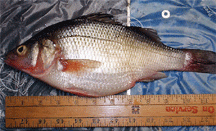
|
Volume XVII, Issue 12 - March 19 - March 25, 2009
|
|
Columns Reviews |
 |
| A white perch management plan has been languishing on DNR drawing boards for almost 10 years. Just this once, let’s not wait for a crisis before we act. |
Springtime’s Silver Lining
White perch follow fast on the tail of yellows

My light spin rod was straining as I eased the spunky fish closer to the boat. Then, nearing the side, the unseen creature sounded, and I had to plunge the rod tip deep into the water as it crossed under us. My thin, six-pound-test mono would easily part if it contacted the boat hull or, worse, tangled in the motor.
The stubborn critter made two more runs for bottom before I managed to get it out from under the boat and start it toward the surface. Peering into the water and hoping to see the golden flash of a yellow perch, I was surprised by a strong glint of silver. It was a white perch, and a good one.
I grabbed the long-handled crab net that we keep handy for landing the bigger pan fish. It would not do to lose this one. The delicate mouth of a heavy perch is quick to tear and shed the hook if you derrick it into the boat. Cautious network and a gentle hand minimize the one that got away stories.
This one was a big male, near 11 inches, probably eight or nine years old, black backed and in prime spawning condition. I dropped him into the cooler and lip-hooked another bull minnow on the spoon that had done him in. Then, inspecting the grass shrimp still adorning a shad dart that hung on a dropper farther up the line, I chucked the rig back into the same area.
It didn’t take but a turn or two on my reel handle, and I was hooked up with another strong fish. I looked over at my partner to gloat, but Dave already had his hands full with a double hook-up, a perch on each of his lures: a yellow and a white. Netting them together, he then settled down to untangling his lures from the folds of the net. In the meantime, I got my whitey to the side.
It was another nice fish, but the hook was held by just a thread of the fish’s mouth tissue. I couldn’t lift it into the boat without the hook tearing free, and Dave still hadn’t gotten his lures extricated from the net. As I silently debated alternative strategies, the chunky rascal decided the issue himself. With a final heave, he pulled loose and disappeared back into the depths.
Spring’s Double Hook-up
We were both surprised by this sudden appearance of white perch during a strong yellow perch run. We shouldn’t have been, for their spawning seasons overlap. The neds run February through the first part of April, and the whites start up sometime in March. The species I prefer on the table is the one in the fish box that day. They are both too excellent to rank.
Both fish are long-lived, sometimes reaching 15 years. The yellows generally attain a larger size, but they are outnumbered by white perch. Our most prolific fish, white perch are caught more frequently than any other Bay species by both recreational and commercial fishermen.
Fish are Biting
The yellow perch run is in full swing, and the white perch run has begun. Trophy rockfish season is only a month away. What’s not to like about spring on the Tidewater?
Resource Alert
The commercial netting of white perch in recent years has reached one million pounds annually, while the recreational take is estimated at half that amount. As other species — including crabs, clams and oysters — have fallen victim to overharvesting and degraded habitat, commercial attention has shifted to white perch.
Today there is still an unlimited commercial harvest permitted, although an eight-inch minimum size is in place (in case you wondered why there are so many little perch and so few big ones). These fish are not usually sold in Maryland but are destined for markets in the Midwest. Although Maryland Department of Natural Resources reports that the white perch population appears to be holding steady, if past is prologue, that will not continue much longer.
A white perch management plan has been languishing on DNR drawing boards for almost 10 years. It may be time for the half-million licensed recreational fishermen to impress upon our state that this is a public resource and should be carefully managed. Just this once, let’s not wait for a crisis before we act.